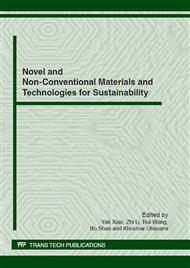p.184
p.189
p.197
p.203
p.208
p.213
p.217
p.222
p.227
Experimental Study of Twin Round Bamboo Concrete Infill Parabolic Tied Arch
Abstract:
This paper is concerned about the experimental study of twin round bamboo concrete infill composite parabolic tied arch. Experimental investigation is undertaken to validate the structural load bearing capacity of haritha infill arch. The infill arch is tested under three types of loading condition viz a) crown point loading, b) centre half loading and c) distributed point loading. The experimental results brings out the stiffness of the arch to be 1 kN/mm under crown point loading, 1.67 kN/mm under centre half loading and 1.17 kN/mm under distributed loading. The stresses in the materials are well within their allowable limits. Thus this paper is able to successfully report the structural strength of parabolic tied infill arch which promises to be a structural load bearing element. Since, there is no additional formwork required in casting of the arch, apart from the bamboo which itself acts like the formwork, lesser quantity of steel and very small thickness of concrete being involved, the arch qualifies to be a potential structural element for affordable housing and green constructions.
Info:
Periodical:
Pages:
208-212
Citation:
Online since:
June 2012
Authors:
Keywords:
Price:
Сopyright:
© 2012 Trans Tech Publications Ltd. All Rights Reserved
Share:
Citation:


